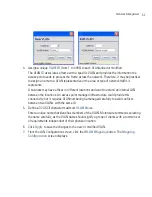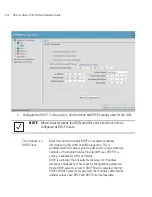
AP-51xx Access Point Product Reference Guide
5-12
3.
Click
Apply
to save any changes to the LAN1 or LAN2 screen. Navigating away from the
screen without clicking the Apply button results in all changes to the screen being lost if the
prompts are ignored.
4.
Click
Undo Changes
(if necessary) to undo any changes made. Undo Changes reverts the
settings displayed on the LAN1 or LAN2 screen to the last saved configuration.
5.
Click
Logout
to securely exit the Access Point applet. A prompt displays confirming the
logout before the applet is closed.
5.1.2.1 Configuring Advanced DHCP Server Settings
Use the
Advanced DHCP Server
screen to specify (reserve) static (or fixed) IP addresses for specific
devices. Every wireless, 802.11x-standard device has a unique
Media Access Control (MAC)
address.
This address is the device's hard-coded hardware number (shown on the bottom or back). An example
of a MAC address is 00:A0:F8:45:9B:07.
The DHCP server can grant an IP address for as long as it remains in active use. The lease time is the
number of seconds an IP address is reserved for re-connection after its last use. Using very short
leases, DHCP can dynamically reconfigure networks in which there are more computers than
available IP addresses. This is useful, for example, in education and customer environments where
MU users change frequently. Use longer leases if there are fewer users.
Secondary DNS
Server
Motorola recommends entering the numerical IP address of an
additional DNS server (if available), used if the primary DNS server
goes down. A maximum of two DNS servers can be used.
WINS Server
Enter the numerical (non DNS name) IP address of the WINS server.
WINS is a Microsoft NetBIOS name server. Using a WINS server
eliminates the broadcasts needed to resolve computer names to IP
addresses by providing a cache or database of translations.
Mesh STP
Configuration
Click the
Mesh STP Configuration
button to define bridge
settings for this specific LAN. Each of the access point’s two LANs
can have a separate mesh configuration. As the
Spanning Tree
Protocol
(STP) mentions, each mesh network maintains hello,
forward delay and max age timers. These settings can be used as
is using the current default settings, or be modified. However, if
these settings are modified, they need to be configured for the LAN
connecting to the mesh network WLAN.
For information on mesh networking capabilities, see
Configuring
Mesh Networking on page 9-1
. If new to mesh networking and in
need of an overview, see
Mesh Networking Overview on page 9-1
.
Summary of Contents for AP 5131 - Wireless Access Point
Page 1: ...AP 51xx Access Point Product Reference Guide ...
Page 3: ...AP 51xx Access Point Product Reference Guide 72E 103901 01 January 2008 ...
Page 4: ......
Page 44: ...AP 51xx Access Point Product Reference Guide 1 28 ...
Page 76: ...AP 51xx Access Point Product Reference Guide 2 32 ...
Page 92: ...AP 51xx Access Point Product Reference Guide 3 16 ...
Page 588: ...AP 51xx Access Point Product Reference Guide 8 254 ...
Page 610: ...AP 51xx Access Point Product Reference Guide 9 22 3 Define a mesh supported WLAN ...
Page 623: ...Configuring Mesh Networking 9 35 3 Determine the Radio MAC Address and BSSID MAC Addresses ...
Page 653: ...Adaptive AP 10 25 line con 0 line vty 0 24 end ...
Page 654: ...AP 51xx Access Point Product Reference Guide 10 26 ...
Page 666: ...AP 51xx Access Point Product Reference Guide A 12 ...
Page 690: ...AP 51xx Access Point Product Reference Guide C 4 ...
Page 696: ...AP 51xx Access Point Product Reference Guide IN 10 ...
Page 697: ......






























